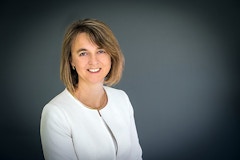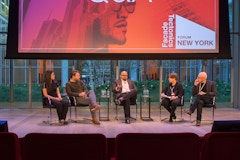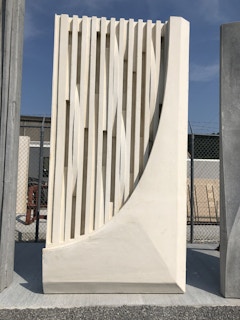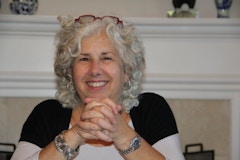
128 results
-

-

Form Follows Well-Being: An Approach to Human Centric Facade Design
- Article by Timo Schmidt, Prof. Dr. · David Bjelland, M.Sc.
Professor Timo Schmidt and Research Assistant David Bjelland of the University of Applied Sciences, Augsburg, propose a human centric planning guide for façade design that provides a tool to optimize façade components to match enhanced occupant well-being and health.
-

Connecting Composites to Sustainability: Probabilistic LCA, Industrialized Construction, and Digital Twinning
- Article by Michael D. Lepech
Material flows of the fossil fuel industry, from exploration and extraction to distribution and combustion, are massive on a global scale. In 2019, the world produced approximately 80 million barrels of crude oil per day, with most being used as a feedstock for combustible fuels.
-
Facade Tectonics Institute Recognizes Industry Leaders with the Vitruvian Honors & Awards
- Article by Mic Patterson, PhD LEED AP+, Ambassador of Innovation & Collaboration
In this first 2022 issue of SKINS, we pause to look back on 2021 through our most-read stories of the year, which we’ve recycled here in case you missed them. The very first thing we see is the inaugural Vitruvian Honors & Awards (VH&A) program conducted virtually. It was a spectacular event!
-
Cool precast concrete enclosure studies from Washington U. in St. Louis
- Article by Pablo Moyano Fernandez, Assistant Professor
Precast Concrete Enclosures is an elective course taught by Assistant Professor Pablo Moyano Fernandez at Washington University in St. Louis. The primary goal of the course is to enable students to envision and materialize full-scale building envelopes using precast concrete.
-

The Perkins&Will Research Journal: Contributions from Practice-Based Design Research
- Article by Kalpana Kuttaiah, Associate AIA, LEED BD+C
Today the design professions still struggle to understand the nature of research in our work. There is a systemic lack of clarity in defining research in design and developing metrics to evaluate the value behind design interventions and applications
-

Turning Up the Heat: Back to the Basics with Thermal Performance
- Article by Mic Patterson, PhD, LEED AP+, Executive Editor, SKINS
It’s that time of year as the holidays approach and heating bills climb. Next to moisture control, thermal behavior has occupied the top spot in performance considerations of the facade system for many years now. So how are we doing? Not so hot!
-

Dr. Helen Sanders Steps into the Role of FTI President for 2017
Dr. Helen Sanders has donned the mantle of leadership as President of the Facade Tectonics Institute. Dr. Sanders replaces Mic Patterson, the Institute’s inaugural President since its founding.
-

Observations on Collaborative Process and Materiality from the Architectural Ceramic Assemblies Workshop
As an industry, we talk a lot about collaboration but the walk, not so much. This ceramics workshop is a stellar example of industry/academic/professional collaboration and worthy of the highest praise. We need more of this!
-

RECAP – Facade Tectonics Forum: NYC! Expands and Amplifies the Better Buildings Dialogue
The recent Forum— Outside the Lines: Building Facades Redefine Urban Living in NYC —hosted by the Ornamental Metals Institute of New York was a rousing event that featured what is certainly among the best speaker programs ever organized by the Facade Tectonics Institute.
-
In pursuit of nothing: Leveraging the facade system for net-zero-carbon
- Article by Rodrigo Borghino, Partner
-

Deep green skins: Façade assembly design for adaptive capacity, durability, and disassembly
- Article by Mic Patterson PhD
The façade system is a potent potential lever for bringing transformative change to buildings and urban habitat in the pursuit of carbon reduction and net zero carbon goals. Nothing in architecture combines attributes of appearance and performance as does the building façade.
-

Energy conservation code updates promise to reshape the way facades are designed
- Article by Elliot Glassman
Ever-increasing performance requirements in the latest version of the energy codes are compelling project teams to consider the thermal performance of the building envelope more rigorously than ever before.
-

Research Collaboration between Industry and Academia as a Driver for Facades Innovation
- Article by Alexandra Blakeslee · Helen Sanders, PhD
Technoform recently embarked on a research project with the University of Massachusetts Amherst and are excited about the opportunity to collaborate with academia. We believe that building strong partnerships and networks that lead to shared results progresses the industry.
-
RECAP – CTBUH 2015 Host Room Assembles World-Class Lineup of Building Facade Specialists
On October 26th and 27th, the Facade Tectonics Institute assembled a world-class lineup of building facade specialists at the CTBUH 2015 International Conference in New York City.
-
The Millennium IGU: A Regenerative Concept for a 1000 Year Insulated Glass Unit
The Millennium IGU: A Regenerative Concept for a 1000 Year Insulated Glass Unit is an ongoing series published by the Advanced Technology Studio of Enclos examining the undesirable lifecycle impacts associated with conventional IGU production, use and disposal.
-

Reglazing Modernism: The American and European Experience with Steel Frame Assemblies to Date
Metal-framed glazed enclosures define contemporary architecture. But as our 20th century building stock continues to age, the restoration, rehabilitation and replacement of underperforming facades has created a specialized field of physicists and preservationists.
-
Tactics to Expand Diversity and Inclusion in the Workforce: Mentoring and Apprentice Programs
- Article by Valerie Block, LEED AP, CDT, Executive Director
I remember taking a career test when I was in middle school. The outcome? I had a supposed interest in becoming a forest ranger. This seemed odd to me--in that I lived in a large metropolitan city and had never been in a forest.
-

Research and Life-Long Learning Opportunities for Practitioners: Perspectives of Professional PhD Students
- Article by Ajla Aksamija · Suncica Milosevic · Hossam Mahmoud
This article is based on an interview with two of my current PhD students, Sunčića (Sunny) Milošević and Hossam Mahmoud. Sunny is an architectural designer and Hossam is a practicing mechanical engineer.
-

Plant-based Architecture and Living Facades: The Intersection of Biology and the Building Skin
- Article by Mic Patterson, PhD LEED AP+
A question for architects and building industry: Can our cities be part of the solution to the challenges facing humanity, or are they intrinsically and inevitably a big part of the problem? To move beyond the latter demands nothing less than a fundamental shift in the way we think about buildings.

